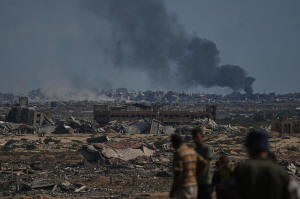Trump orders Israel to stop bombing Gaza after Hamas partially accepts
his peace plan
[October 04, 2025]
By WAFAA SHURAFA, BASSEM MROUE and JOSEPH KRAUSS
DEIR AL-BALAH, Gaza Strip (AP) — U.S. President Donald Trump on Friday
ordered Israel to stop bombing the Gaza Strip after Hamas said it had
accepted some elements of his plan to end the nearly two-year war and
return all the remaining hostages taken in the Oct. 7, 2023, attack.
Hamas said it was willing to release the hostages and hand over power to
other Palestinians, but that other aspects of the plan require further
consultations among Palestinians. Senior Hamas officials suggested there
were still major disagreements that required further negotiations.
Prime Minister Benjamin Netanyahu said Israel was prepared for the
implementation of the “first stage” of Trump's plan, apparently
referring to the release of hostages. But his office said in a statement
that Israel was committed to ending the war based on principles it has
set out before, without addressing potential gaps with Hamas.
Trump welcomed the Hamas statement, saying: “I believe they are ready
for a lasting PEACE."
“Israel must immediately stop the bombing of Gaza, so that we can get
the Hostages out safely and quickly! Right now, it’s far too dangerous
to do that. We are already in discussions on details to be worked out,"
he wrote on social media.
Hamas said aspects of the proposal touching on the future of the Gaza
Strip and Palestinian rights should be decided on the basis of a
“unanimous Palestinian stance” reached with other factions and based on
international law.

The statement also made no mention of Hamas disarming, a key Israeli
demand included in Trump’s proposal.
Latest ceasefire effort is widely welcomed
Trump appears keen to deliver on pledges to end the war and return
dozens of hostages ahead of the second anniversary of the attack on
Tuesday.
Key mediators Egypt and Qatar welcomed the latest developments, and
Majed Al Ansari, a spokesman for Qatar's Foreign Ministry, said they
would “continue discussions on the plan.”
A spokesman for U.N. Secretary-General António Guterres said he “urges
all parties to seize the opportunity to bring the tragic conflict in
Gaza to an end.” French President Emmanuel Macron wrote on social media
that “the release of all hostages and a ceasefire in Gaza are within
reach!”
The main organization representing the families of Israeli hostages said
Trump's demand to halt the fighting “is essential to prevent serious and
irreversible harm to the hostages." It called on Netanyahu “to
immediately begin efficient and swift negotiations to bring all our
hostages home.”
Trump’s plan would end the fighting and return hostages
Earlier, Trump had warned that Hamas must agree to the deal by Sunday
evening, threatening an even greater military onslaught.
“If this LAST CHANCE agreement is not reached, all HELL, like no one has
ever seen before, will break out against Hamas," Trump wrote Friday on
social media. "THERE WILL BE PEACE IN THE MIDDLE EAST ONE WAY OR THE
OTHER.”
Under the plan, which Trump unveiled earlier this week alongside
Netanyahu, Hamas would release the remaining 48 hostages — around 20 of
them believed to be alive — within three days. It would also give up
power and disarm.
In return, Israel would halt its offensive and withdraw from much of the
territory, release hundreds of Palestinian prisoners and allow an influx
of humanitarian aid and eventual reconstruction. Plans to relocate much
of Gaza's population to other countries would be shelved.
The territory of some 2 million Palestinians would be placed under
international governance, with Trump himself and former British Prime
Minister Tony Blair overseeing it. The plan provides no path for
eventual reunification with the Israeli-occupied West Bank in a future
Palestinian state.
Palestinians long for an end to the war, but many view this and previous
U.S. proposals as strongly favoring Israel.
Hamas officials air objections in TV interviews
Trump’s proposal “cannot be implemented without negotiations,” Mousa Abu
Marzouk, a senior Hamas official based outside of Gaza, told the Al
Jazeera network on Friday.
[to top of second column]
|

Smoke rises to the sky following an Israeli military strike in Gaza
City, as seen from the central Gaza Strip, Thursday, Oct. 2, 2025.
(AP Photo/Abdel Kareem Hana)

The Hamas statement said it was willing to return all remaining
hostages according to the plan’s “formula,” apparently referring to
an exchange for hundreds of Palestinian prisoners. It also
reiterated its longstanding openness to handing power over to a
politically independent Palestinian body.
But Abu Marzouk said it might be difficult for Hamas to release all
the hostages within 72 hours, because it could take days or weeks to
locate the remains of some of the captives.
He said Hamas was willing to hand over its weapons to a future
Palestinian body that runs Gaza, but there was no mention of that in
the official statement.
Another Hamas official, Osama Hamdan, told Al Araby television that
Hamas would refuse foreign administration of the Gaza Strip and that
the entry of foreign forces would be “unacceptable.”
US and Israel seek to pressure Hamas
Israel has sought to ramp up pressure on Hamas since ending an
earlier ceasefire in March. It sealed the territory off from food,
medicine and other goods for 2 1/2 months and has seized, flattened
and largely depopulated large areas.
Experts determined that Gaza City had slid into famine shortly
before Israel launched a major offensive aimed at occupying it. An
estimated 400,000 people have fled the city in recent weeks, but
hundreds of thousands more have stayed behind.
Olga Cherevko, a spokesperson for the U.N. humanitarian office, said
she saw several displaced families staying in the parking lot of
Shifa Hospital during a visit on Thursday.
“They are not able to move south because they just cannot afford
it,” Cherevko told The Associated Press. “One of the families had
three children and the woman was pregnant with her fourth. And there
were many other vulnerable cases there, including elderly people and
people with disabilities.”
Most of Hamas' top leaders in Gaza and thousands of its fighters
have already been killed, but it still has influence in areas not
controlled by the Israeli military and launches sporadic attacks.
Hamas has long insisted it will only release the remaining hostages
— its sole bargaining chip and potential human shields — in exchange
for a lasting ceasefire and an Israeli withdrawal. Netanyahu has
rejected those terms, saying Hamas must surrender and disarm.

Second anniversary approaches
Thousands of Hamas-led militants stormed into Israel on Oct. 7,
2023, attacking army bases, farming communities and an outdoor music
festival, killing some 1,200 people, mostly civilians. They abducted
251 others, most of them since released in ceasefires or other
deals.
Israel's retaliatory offensive has killed more than 66,000
Palestinians, according to Gaza's Health Ministry, which does not
say how many were civilians or combatants. It says women and
children make up around half the dead.
The ministry is part of the Hamas-run government, and the U.N. and
many independent experts consider its figures to be the most
reliable estimate of wartime casualties.
The offensive has displaced around 90% of Gaza's population, often
multiple times, and left much of the territory uninhabitable.
Both the Biden and Trump administrations have tried to end the
fighting and bring back the hostages while providing extensive
military and diplomatic support to Israel.
___
Mroue reported from Beirut and Krauss from Ottawa, Ontario.
Associated Press writers Fatma Khaled in Cairo and Chris Megerian in
Washington contributed.
All contents © copyright 2025 Associated Press. All rights reserved |